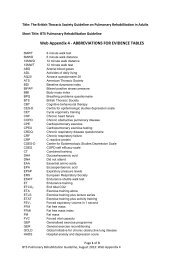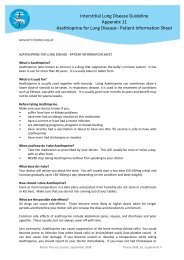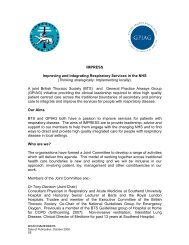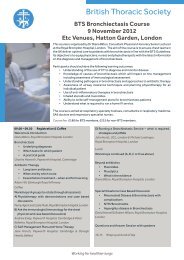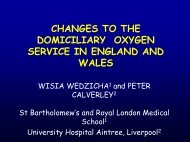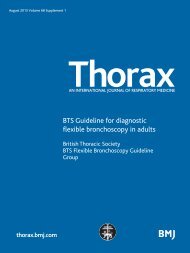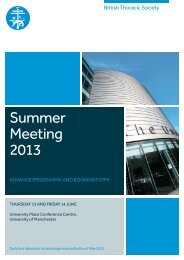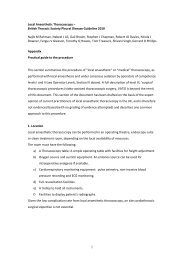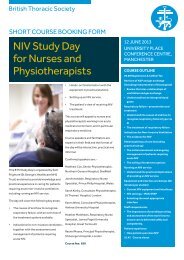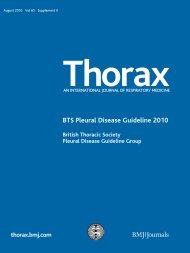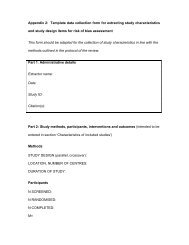Guidelines for the management of community ... - Brit Thoracic
Guidelines for the management of community ... - Brit Thoracic
Guidelines for the management of community ... - Brit Thoracic
You also want an ePaper? Increase the reach of your titles
YUMPU automatically turns print PDFs into web optimized ePapers that Google loves.
BTS guidelines<br />
microbiological diagnosis has been made by o<strong>the</strong>r means<br />
(eg, culture, urine antigen, PCR) and who fail to improve,<br />
and/or where <strong>the</strong>re are particular epidemiological risk<br />
factors. [D] The date <strong>of</strong> onset <strong>of</strong> symptoms should be<br />
clearly indicated on all serological request <strong>for</strong>ms. [D]<br />
40. Serological tests may be extended to all patients admitted<br />
to hospital with CAP during outbreaks and when needed<br />
<strong>for</strong> <strong>the</strong> purposes <strong>of</strong> surveillance. The criteria <strong>for</strong> per<strong>for</strong>ming<br />
serology tests in <strong>the</strong>se circumstances should be agreed<br />
locally between clinicians, laboratories and public health.<br />
[D]<br />
Severity assessment (Section 6)<br />
What severity assessment strategy is recommended?<br />
41. Clinical judgement is essential in disease severity assessment.<br />
[D]<br />
42. The stability <strong>of</strong> any comorbid illness and a patient’s social<br />
circumstances should be considered when assessing disease<br />
severity. [D]<br />
Severity assessment <strong>of</strong> CAP in patients seen in <strong>the</strong> <strong>community</strong><br />
43. For all patients, clinical judgement supported by <strong>the</strong><br />
CRB65 score should be applied when deciding whe<strong>the</strong>r<br />
to treat at home or refer to hospital. [D]<br />
44. Patients who have a CRB65 score <strong>of</strong> 0 are at low risk <strong>of</strong><br />
death and do not normally require hospitalisation <strong>for</strong><br />
clinical reasons. [B+]<br />
45. Patients who have a CRB65 score <strong>of</strong> 1 or 2 are at increased<br />
risk <strong>of</strong> death, particularly with a score <strong>of</strong> 2, and hospital<br />
referral and assessment should be considered. [B+]<br />
46. Patients who have a CRB65 score <strong>of</strong> 3 or more are at high<br />
risk <strong>of</strong> death and require urgent hospital admission. [B+]<br />
47. When deciding on home treatment, <strong>the</strong> patient’s social<br />
circumstances and wishes must be taken into account in<br />
all instances. [D]<br />
Severity assessment <strong>of</strong> CAP in patients seen in hospital<br />
48. For all patients, <strong>the</strong> CURB65 score should be interpreted in<br />
conjunction with clinical judgement. [D]<br />
49. Patients who have a CURB65 score <strong>of</strong> 3 or more are at high<br />
risk <strong>of</strong> death. These patients should be reviewed by a<br />
senior physician at <strong>the</strong> earliest opportunity to refine<br />
disease severity assessment and should usually be managed<br />
as having high severity pneumonia. Patients with CURB65<br />
scores <strong>of</strong> 4 and 5 should be assessed with specific<br />
consideration to <strong>the</strong> need <strong>for</strong> transfer to a critical care<br />
unit (high dependency unit or intensive care unit). [B+]<br />
50. Patients who have a CURB65 score <strong>of</strong> 2 are at moderate<br />
risk <strong>of</strong> death. They should be considered <strong>for</strong> short-stay<br />
inpatient treatment or hospital-supervised outpatient<br />
treatment. [B+]<br />
51. Patients who have a CURB65 score <strong>of</strong> 0 or 1 are at low risk<br />
<strong>of</strong> death. These patients may be suitable <strong>for</strong> treatment at<br />
home. [B+]<br />
52. When deciding on home treatment, <strong>the</strong> patient’s social<br />
circumstances and wishes must be taken into account in<br />
all instances. [D]<br />
Reviewing severity status after initial assessment<br />
53. Regular assessment <strong>of</strong> disease severity is recommended <strong>for</strong><br />
all patients following hospital admission. The ‘‘post take’’<br />
round by a senior doctor and <strong>the</strong> medical team provides<br />
one early opportunity <strong>for</strong> this review. [D]<br />
54. All patients deemed at high risk <strong>of</strong> death on admission to<br />
hospital should be reviewed medically at least 12-hourly<br />
until shown to be improving. [D]<br />
General <strong>management</strong> (Section 7)<br />
General <strong>management</strong> strategy <strong>for</strong> patients treated in <strong>the</strong> <strong>community</strong><br />
55. Patients with suspected CAP should be advised to rest, to<br />
drink plenty <strong>of</strong> fluids and not to smoke. [D]<br />
56. Pleuritic pain should be relieved using simple analgesia<br />
such as paracetamol. [D]<br />
57. The need <strong>for</strong> hospital referral should be assessed using <strong>the</strong><br />
criteria recommended in section 6. [C]<br />
58. Pulse oximetry, with appropriate training, should be<br />
available to general practitioners and o<strong>the</strong>rs responsible <strong>for</strong><br />
<strong>the</strong> assessment <strong>of</strong> patients in <strong>the</strong> out-<strong>of</strong>-hours setting <strong>for</strong> <strong>the</strong><br />
assessment <strong>of</strong> severity and oxygen requirement in patients<br />
with CAP and o<strong>the</strong>r acute respiratory illnesses. [D]<br />
Review policy <strong>for</strong> patients managed in <strong>the</strong> <strong>community</strong><br />
59. Review <strong>of</strong> patients in <strong>the</strong> <strong>community</strong> with CAP is<br />
recommended after 48 h or earlier if clinically indicated.<br />
Disease severity assessment should <strong>for</strong>m part <strong>of</strong> <strong>the</strong> clinical<br />
review. [D]<br />
60. Those who fail to improve after 48 h <strong>of</strong> treatment should<br />
be considered <strong>for</strong> hospital admission or chest radiography.<br />
[D]<br />
General <strong>management</strong> strategy <strong>for</strong> patients treated in hospital<br />
61. All patients should receive appropriate oxygen <strong>the</strong>rapy<br />
with monitoring <strong>of</strong> oxygen saturations and inspired<br />
oxygen concentration with <strong>the</strong> aim to maintain arterial<br />
oxygen tension (PaO 2 )at>8 kPa and oxygen saturation<br />
(SpO 2 ) 94–98%. High concentrations <strong>of</strong> oxygen can safely<br />
be given in patients who are not at risk <strong>of</strong> hypercapnic<br />
respiratory failure. [D]<br />
62. Oxygen <strong>the</strong>rapy in patients at risk <strong>of</strong> hypercapnic<br />
respiratory failure complicated by ventilatory failure<br />
should be guided by repeated arterial blood gas measurements.<br />
[C]<br />
63. Patients should be assessed <strong>for</strong> volume depletion and may<br />
require intravenous fluids. [C]<br />
64. Prophylaxis <strong>of</strong> venous thromboembolism with low molecular<br />
weight heparins should be considered <strong>for</strong> all patients<br />
who are not fully mobile. [A+]<br />
65. Nutritional support should be given in prolonged illness.<br />
[C]<br />
66. Medical condition permitting, patients admitted to hospital<br />
with uncomplicated CAP should sit out <strong>of</strong> bed <strong>for</strong> at<br />
least 20 min within <strong>the</strong> first 24 h and mobility should be<br />
increased each subsequent day <strong>of</strong> hospitalisation. [A2]<br />
67. Patients admitted with uncomplicated pneumonia should<br />
not be treated with traditional airway clearance techniques<br />
routinely. [B+]<br />
68. Patients should be <strong>of</strong>fered advice regarding expectoration if<br />
<strong>the</strong>re is sputum present. [D]<br />
69. Airway clearance techniques should be considered if <strong>the</strong><br />
patient has sputum and difficulty with expectoration or in<br />
<strong>the</strong> event <strong>of</strong> a pre-existing lung condition. [D]<br />
Monitoring in hospital<br />
70. Temperature, respiratory rate, pulse, blood pressure,<br />
mental status, oxygen saturation and inspired oxygen<br />
Thorax 2009;64(Suppl III):iii1–iii55. doi:10.1136/thx.2009.121434<br />
iii3



